Railway dreadnought. Armored train "Baltiets"
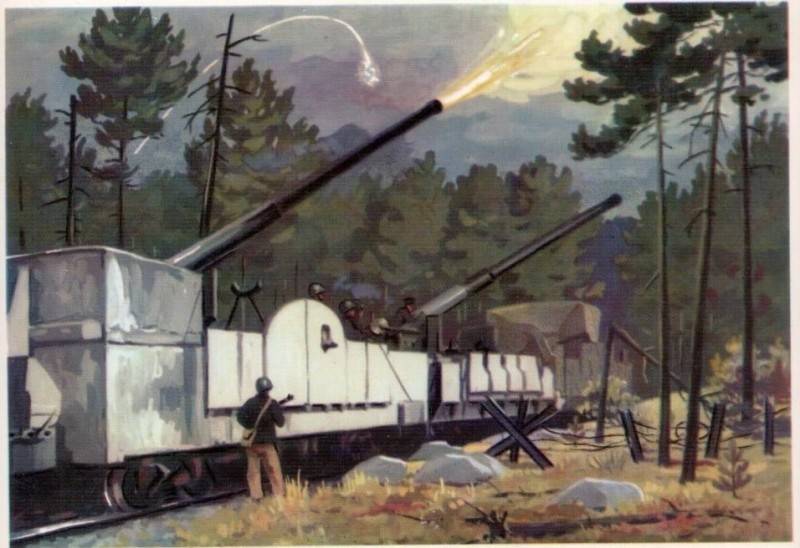
Armored trains entered history of our country primarily as the heroes of the Civil War. Both red and white actively used railways. In total, during the Civil War in the territory of the former Russian Empire, warriors built and used four hundred armored trains in battle. Over the years of the war, the young Red Army gained vast experience in the use of armored rolling stock. This experience was later used already in the Red Army.
Armored trains have proven themselves excellently in providing fire support to the ground forces, as well as conducting daring raids and independent combat operations in the existing railroad strip. By the end of the Civil War, the Red Army had more than 120 armored trains, not counting those that were sent for storage. By the time World War II began, armored trains had not lost their relevance, although their number was reduced. By June 22, 1941, the Red Army possessed about fifty armored trains, a third of which was concentrated in the Far East. Another dozen armored trains were at the disposal of the NKVD, these trains were part of the divisions of the NKVD for the protection of railways formed in the border areas.
Armored trains located in the western districts of the country, from the very first days of the war, took part in battles with the Nazi troops. As the Soviet troops retreated to the internal regions of the USSR, new armored trains began to be created in the country, some of them went to the front in 1941, as happened in the Leningrad and Oranienbaum bridgehead areas. On the bridgehead from autumn 1941 to January 1944 until the complete lifting of the siege of Leningrad, there were two armored trains: the Baltiets and For the Motherland!, Which for over two years supported the heroic defenders of the bridgehead.
The first battles of the future armored train “Baltiets”
Both armored trains, which were at the disposal of the defenders of the Oranienbaum bridgehead, arrived there from the Baltic. According to historians working at the Fort Red Hill Museum, these were the old armored trains of the Latvian army, which managed to break through from the Baltic literally under the nose of the Germans. At the same time, both armored trains were seriously damaged. According to eyewitnesses, the armored trains were in poor condition and were actually broken.
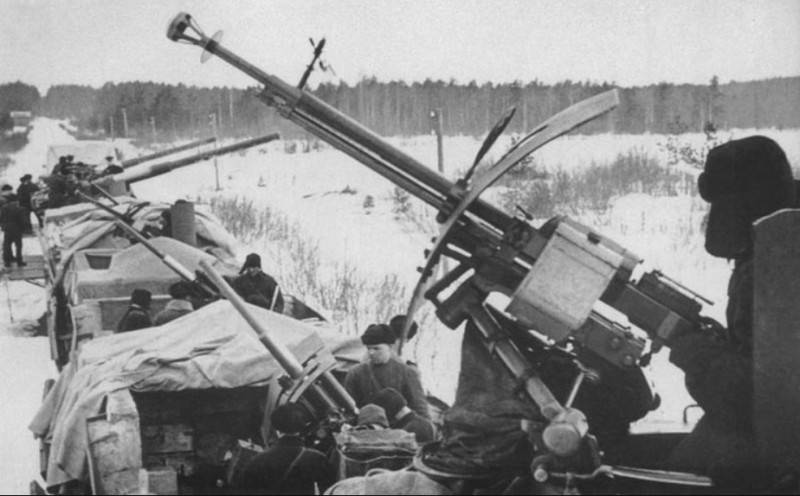
As far back as June 1941, armored train No. 7, which would later be called Baltiets, was located in the Baltic states, where it underwent major repairs at local enterprises. The armored train was originally part of the coastal defense forces of the Red Banner Baltic fleet. The main armament of the armored train was atypically powerful for Soviet armored trains, the naval specifics were imposed. The armored train was armed with four 102-mm artillery pieces and about 15 Maxim machine guns.
With the outbreak of World War II, the repair of the armored train was promptly completed, and the train received its first combat order on June 23. The command ordered the withdrawal of armored train number 7 in the area of the Vindava station (Ventspils), where he was to participate in repelling the Nazi raids aviation to the airfield located here. It is worth noting that the air defense tasks in those days were often assigned to armored trains. So, from July to October 1941, it was possible to form six anti-aircraft armored trains at once on the Oktyabrskaya Railway, each of which consisted of a steam locomotive equipped with an armored booth, and six armored platforms on which anti-aircraft guns and machine guns were located, as well as storage wagons and fireplaces for personnel .
The future Baltiets armored train fought along with the forces of the 8th Army, participated in battles near Liepaja, Jelgava, Riga, and Tallinn. The armored train left the Baltic states in poor condition, breaking through the stations occupied by the Germans. Therefore, at first the command was going to dismantle it, but in the end the decision was revised. In fact, only the rolling stock remained from the armored train - the OV series armored locomotive of type 0-4-4 with No. 431 (the famous "sheep"). Both armored trains that erupted from the Baltic reached the Lebyazhye station (Krasnaya Gorka Fort), at the disposal of the Izhora coastal defense sector of the Kronstadt Naval Base (KVMB), whose command decides to form two armored trains, strengthening the sector’s defense.
The second life of armored train number 7
The armored train had to be repaired and brought back to life on its own in the face of a shortage of labor, specialists and materials. The trains had to be restored as soon as possible, equipped with new artillery guns, machine guns, a crew was recruited and sent back into battle. They decided to equip armored trains with high reinforced concrete sides. Specialists of the military workshop No. 146 (Bolshaya Izhora) worked on arranging the foundations of platforms and mounts for guns, the work was headed by the chief engineer of the Izhora sector, military engineer of the second rank Zverev, and also the chief of artillery of the sector, Major Proskurin.
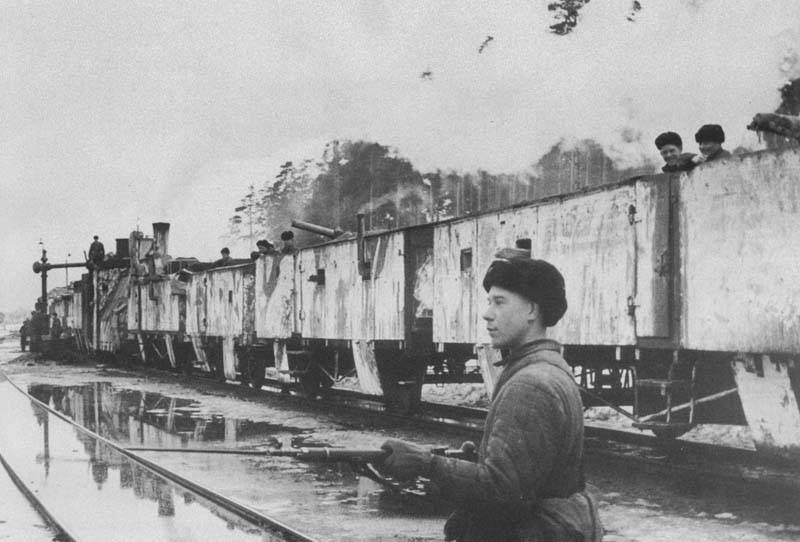
Today, a few hundred meters from the Krasnoflotsk railway platform, now destroyed, you can still find the remains of slabs covered with various debris, which also did not spare time. These reinforced concrete slabs are the remains of armored cars built in the difficult months of 1941. Sliced armored plates for two armored trains of the Izhora coastal defense sector were provided by workers of the Leningrad Metallurgical Plant. The gunners of Fort Krasnaya Gorka and nearby coastal batteries helped with the supply of guns and their repair. The port of Oranienbaum ended up with the necessary cement reserves, which were used to strengthen the reservation.
According to experts, the armored sites were covered by two sheets of 8-10-mm armor, which perfectly protected except from small arms weaponsbut not from shells. But at the same time, there was a ten-centimeter gap between the two sheets of armor, which was reinforced with reinforced concrete. It was such a reinforced concrete structure that took upon itself the main task of ensuring the survivability of the armored train. Alexander Senotrusov, an employee of the Fort Krasnaya Gorka Museum, notes that there were no analogues of such construction of armored trains in the world. The armored train itself consisted of an armored locomotive, two platforms and four armored sites.
To armor an armored train, two batteries were removed from the second northern fort - the 125th and 159th, both batteries of a three-gun composition. The batteries were armed with universal semi-automatic 45 mm 21K guns located on the pedestal installations. In addition, six large-caliber 12,7-mm machine guns, including 4 DShK machine guns and two recreation centers, as well as 16 Maxim machine guns and three DP machine guns were allocated to the armored train to strengthen the air defense. The main armament of the armored train was two marine 102-mm guns with a barrel length of 60 calibers.
These guns manufactured by the Obukhov plant were installed primarily on destroyers and remained in service from 1909 to the early 1950s. The guns turned out to be very successful and were characterized by high ballistic qualities, which determined the durability of their use and completion in small series over the years. The practical rate of fire of the guns reached 12-15 rounds per minute, the maximum firing range of 16 meters (at an elevation angle of 300 degrees). For the defenders of the Oranienbaum bridgehead, armored trains with similar weapons were of great help.
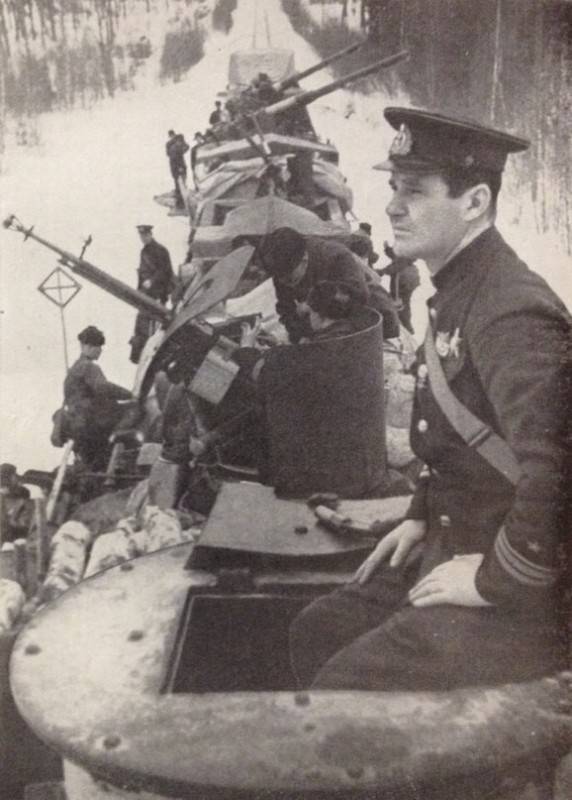
Moreover, on January 31, 1942, the armament of armored train No. 7 was strengthened. At the end of 1941, by order of the Izhora fortified area, which is part of the SEC, the armored train was given a new 60-ton four-axle open railway platform. After testing, a 130-mm gun in a turret installation (aft), shot from the famous cruiser Aurora, was installed on this platform at the end of January. 130-mm gun B-13 with a barrel length of 50 calibres provided a maximum firing range of 25 meters. Rate of fire 500-7 rounds per minute. Already by May 8, the execution of the gun will be approximately 1942 percent.
The fighting of armored trains on the Oranienbaum bridgehead
By September 1941, armored train number 7 took part in battles and repel raids of enemy aircraft. In early September, he participated in the shelling of German troops tearing toward the coast of the Gulf of Finland. After the Germans reached the coast of the Gulf of Finland in mid-September and occupied the city of Peterhof on September 23, two armored trains restored in the Izhora sector were cut off along with troops in the Oranienbaum area. The Germans believed that they took a large group of Soviet troops in the ring, calling the entire encirclement area a "boiler." However, the Soviet troops did not plan to lay down their arms.
Meanwhile, armored trains lost the ability to exit to Leningrad for repairs. In August, they were repaired several times at the Leningrad factories, eliminating damage sustained during raids by enemy aircraft. From mid-September 1941, they could only count on local workshops located in the Oranienbaum region.
On July 30, 1941, Captain V. D. Stukalov entered command of armored train No. 7. This officer will be the permanent commander of the future Baltiets armored train until the beginning of 1944. A little later, on August 14, 1941, the armored train will be assigned No. 7 on the basis of the order of the commander of the Red Banner Baltic Fleet, and the armored train itself will be included in the Izhora UR. From this moment until the complete lifting of the siege of Leningrad, the armored train will operate on the Oranienbaum bridgehead, which for some time will be the westernmost part of the Soviet Union, which was held by Soviet troops. Since August 15, 1941, armored train No. 7 was transferred to wartime staff, its personnel at that time amounted to 105 people. At the beginning of 1942, the staff will be reconsidered again, bringing the number of personnel of the armored train to 153 people.
To ensure armored trains maneuverability on a relatively small bridgehead (maximum front length 65 kilometers, width 25 kilometers), 50 kilometers of railway tracks were specially laid again. It is about building several new branches, as well as 18 new firing positions for armored trains. Their construction was carried out in the Oranienbaum region and west of the Kalishche railway station (today in the city of Sosnovy Bor). In order to minimize losses from return fire and possible air raids, armored trains went to a position, made a fire raid on troops and enemy defenses, lasting no more than 20-25 minutes, after which they necessarily changed their combat position.
On January 23, 1942, by order of the Vice-Admiral Tributs, commander of the Baltic Fleet, the armored train No. 7 for the valor and personal courage shown by the armored train crew in the fight against the Nazi invaders, was given the name "Baltiets", under which he fought until 1944. The second armored train of Izhora UR received the name "For the Motherland!" It is worth noting that under Leningrad there were two armored trains with the same name. The second armored train, "Baltiets", fought in the surrounded Leningrad as part of the troops of the Leningrad Front. Its main difference was armored cars equipped with two towers, shot from tanks KV-1, which were produced in a city besieged by the enemy.
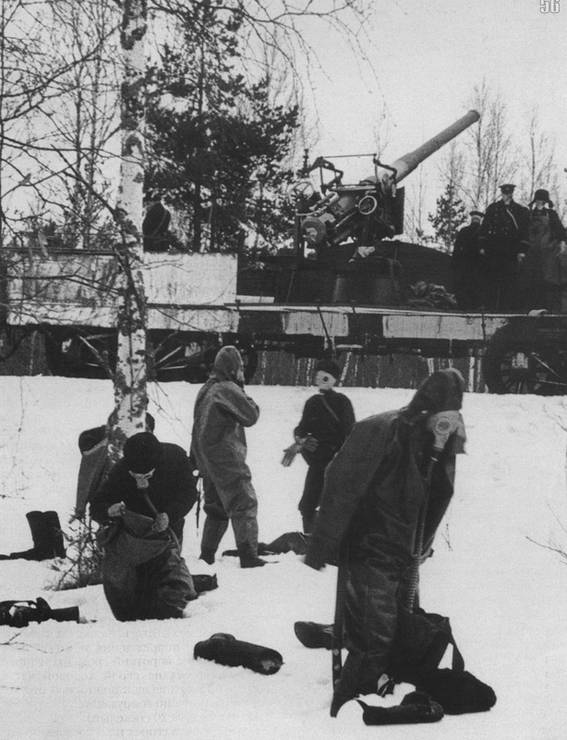
In total, during the years of World War II, the Baltiets armored train that fought on the Oranienbaum bridgehead held more than a hundred combat exits for delivering artillery attacks on enemy troops and communications, opening fire on the enemy 310 times. According to rough estimates, in the first year of its activity alone, about 5 enemy soldiers and officers were destroyed at the front of the Baltiets’s guns, 13 artillery and 23 mortar batteries were destroyed, 69 dugouts were destroyed, as well as 32 different vehicles with enemy infantry, and two were destroyed enemy tanks, 4 aircraft were shot down, 152 houses with firing points equipped inside were destroyed, and 4 command posts and 4 enemy crossings were destroyed. Over the years of the war, an armored train traveled about 15 thousand kilometers on a small defended heel of native land.
September 4, 1944 began to disband his armored train. On September 7, all surviving artillery and machine gun weapons from Baltiets went to storage.
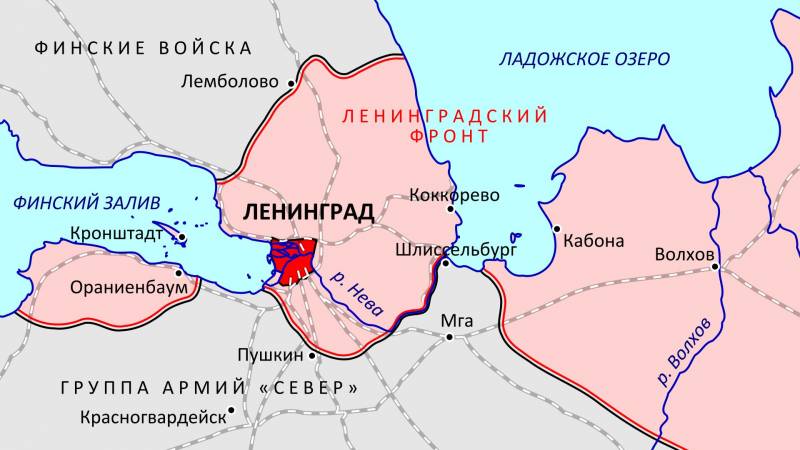
Information